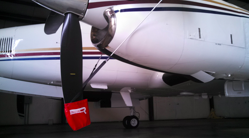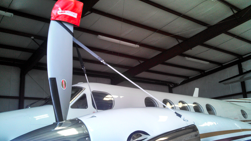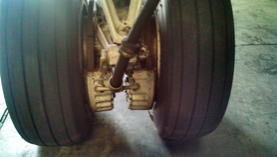In part I of this two part series, we questioned how your experience has been in cold weather operations. We touched on the effect it can have on your airframe and your engines.
Preparations needed to avoid various issues are important. As we all know, airfoils love cold and dense air masse but when mixed with any version of H2O, not as much. Engines, propellers, brakes, instruments and avionics simply despise the very condition that provides us with the great performance we inherit in the winter months.
Propellers:
 Two concerns come to my mind with regards to propellers. First, the prop tie-down/exhaust covers and how you position the propeller tip “pocket”. Most pilots position the pocket on the bottom, strapping up to the exhaust, which is apparently the way Beechcraft and Raisbeck designed it to be situated because in that configuration the logos printed on the pocket are legible and right side up. However, if your aircraft is being stored outside, the elements could theoretically collect inside the pocket and freeze to the blade. This has never happened to me personally, but I always position the pocket at the top and strap down to the exhaust during winter operations, just in case.
Two concerns come to my mind with regards to propellers. First, the prop tie-down/exhaust covers and how you position the propeller tip “pocket”. Most pilots position the pocket on the bottom, strapping up to the exhaust, which is apparently the way Beechcraft and Raisbeck designed it to be situated because in that configuration the logos printed on the pocket are legible and right side up. However, if your aircraft is being stored outside, the elements could theoretically collect inside the pocket and freeze to the blade. This has never happened to me personally, but I always position the pocket at the top and strap down to the exhaust during winter operations, just in case.
 The bigger of the two trepidations with propellers and ice-cold visible moisture is how to use the heat. The standard rule is +5 degrees C and below in visible moisture all anti-ice equipment should be turned on, and more conservatively, +10 C and below. However, in some aircraft, it is labeled/ referred to as Prop De-Ice, but electrically heated prop boots should be used as a preventative measure, which classifies it as an anti-ice device. If you turn it on after the ice has already formed, the ice can shed off and impact the fuselage, or even worse, come off unevenly, thus causing a propeller imbalance and a lot of vibration! Either event will surely get the attention of your passengers and make for an awkward discussion, especially if the paint job gets busted up as a result.
The bigger of the two trepidations with propellers and ice-cold visible moisture is how to use the heat. The standard rule is +5 degrees C and below in visible moisture all anti-ice equipment should be turned on, and more conservatively, +10 C and below. However, in some aircraft, it is labeled/ referred to as Prop De-Ice, but electrically heated prop boots should be used as a preventative measure, which classifies it as an anti-ice device. If you turn it on after the ice has already formed, the ice can shed off and impact the fuselage, or even worse, come off unevenly, thus causing a propeller imbalance and a lot of vibration! Either event will surely get the attention of your passengers and make for an awkward discussion, especially if the paint job gets busted up as a result.
Brakes:
The only situation I will address here is when you have a combination of slushy taxiway/runway conditions and a certain brake conversion kit installed on your 200, 300, or 350. Though I’ve heard of this same scenario happening with the multi disc brakes as well, it seems to be more prevalent with the converted systems. The issue here arises when you are taxiing on said slushy taxiways/runways for takeoff. Because this particular conversion places the brake calipers at the bottom of the brake disc, it’s easy for the snow and water mixture to envelop the brake components. After takeoff and soon after the climb into higher altitudes and diminishing temperatures the liquid becomes solid and creates a pseudo parking brake.
 Upon touchdown, it is possible to flat spot all four main tires, much to the satisfaction of Goodyear and Michelin. I have not personally experienced this situation, but I have taken steps to prevent it by soaking the brake components with isopropyl alcohol just prior to departure and by leaving the gear down after departure for a longer duration of time and I really try to plant the landing instead of greasing it on. Though I did not flat spot any tires on landing, it’s really hard to know if that expedient had any effect in hindering the occurrence.
Upon touchdown, it is possible to flat spot all four main tires, much to the satisfaction of Goodyear and Michelin. I have not personally experienced this situation, but I have taken steps to prevent it by soaking the brake components with isopropyl alcohol just prior to departure and by leaving the gear down after departure for a longer duration of time and I really try to plant the landing instead of greasing it on. Though I did not flat spot any tires on landing, it’s really hard to know if that expedient had any effect in hindering the occurrence.
It is important to note that the use of glycol-based de-icing fluids on carbon brake components should be avoided due to the possibility of catalytic oxidation, which can occur and cause corrosion and eventually, failure of the carbon brake pad. Bleed air brake de-ice is obviously the way to thwart this scenario but not all of us are equipped with this convenience, and those of us who are, know that the use of this advantage comes with its own disadvantages. Either you use it often or not at all. If you don’t use it often, carbon build up with in the system can cause the solenoid to “stick” in the open position, so I have been told,. This can lead to excess heat and a pretty red light on your annunciator panel.
I could go on and on, from dialogue about the use of ceramic heaters connected to electrical timers for preheating the cabin, to removing all the diet sodas to prevent inadvertent pop explosions, but the bottom line is that winter and cold weather operations can be challenging. While a little preparation can go a long way, perhaps your personal experiences will be the ultimate professor. I refer now to a famous quote from Vernon Sanders,
Experience is a hard teacher because she gives the test first, and the lesson afterwards.
As a KingAirNation follower, allow me to welcome you to “The Club”, that is, the club of Beechcraft King Air pilots! As such, we are all a part of the history of arguably the greatest turboprop aircraft ever built!
Try to stay on the right side of the ground, keep the blue side up, and FLY SAFE MY FRIENDS!
[divider]
About the Author: J.D. Marshall
J.D. Marshall is an ATP, CFI, and A&P and has been flying and maintaining aircraft for twenty years. For the last ten years, he has flown in the charter and corporate aviation environment, acquiring over 6000 flight hours of experience in more than 110 different aircraft consisting of 45 different types, taking off and landing at over 400 different airports throughout the United States, Canada and the Caribbean. He has experience in the Beechcraft King Air C90 A/B, E90, 200, B200, 300, and 350.

![KingAir – King of the Cold Part II – [Op-Ed] KingAir – King of the Cold Part II – [Op-Ed]](https://cdn11.bigcommerce.com/s-bng8bbzq86/images/stencil/160w/snowKA2.jpg)